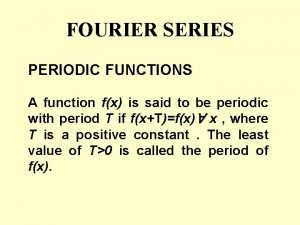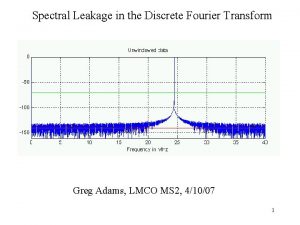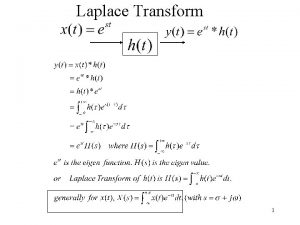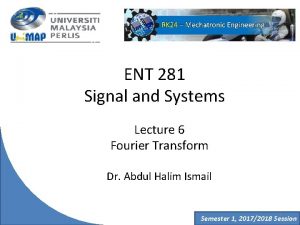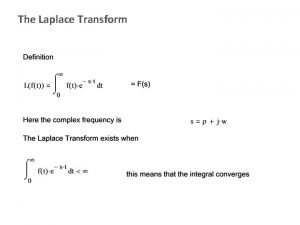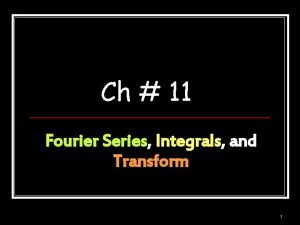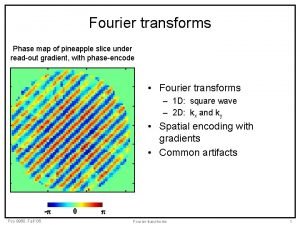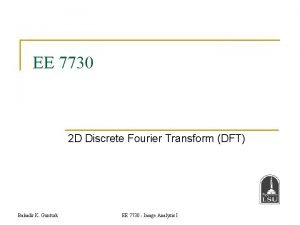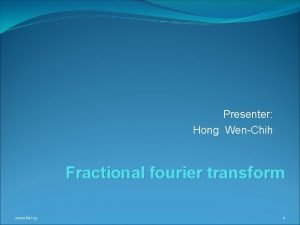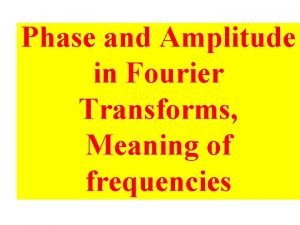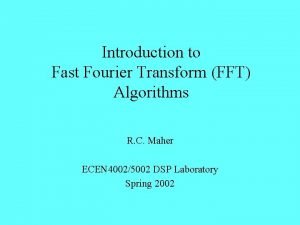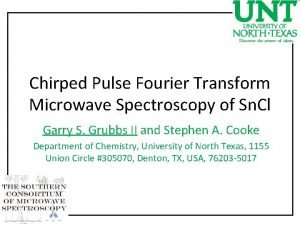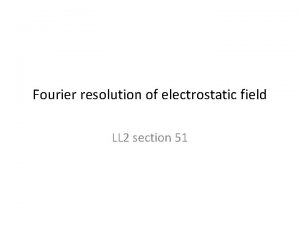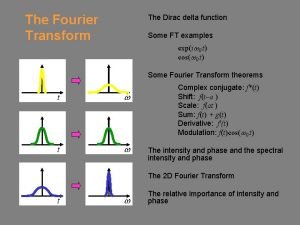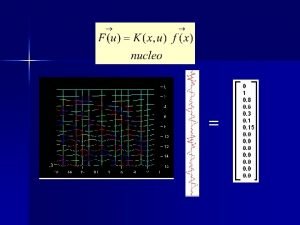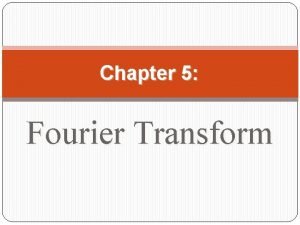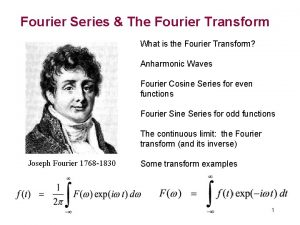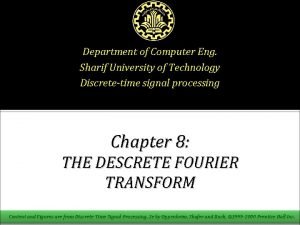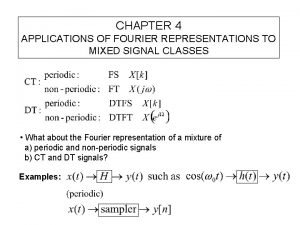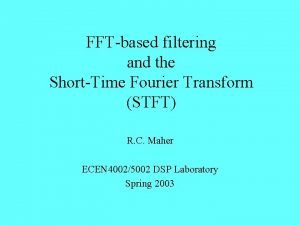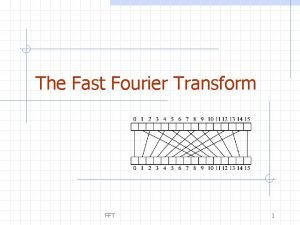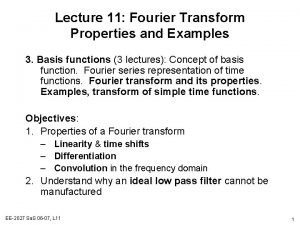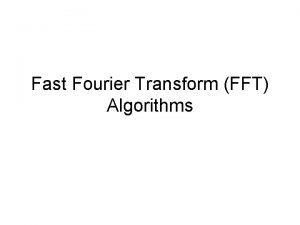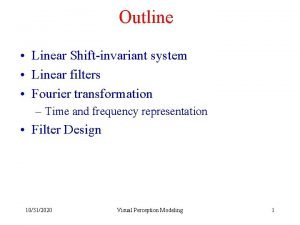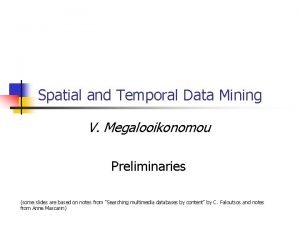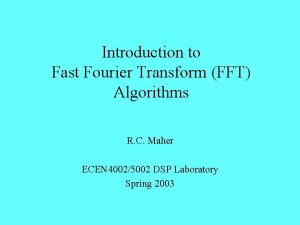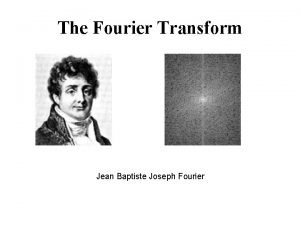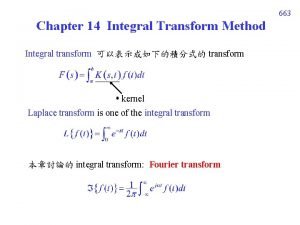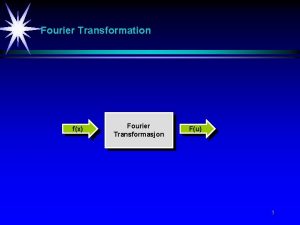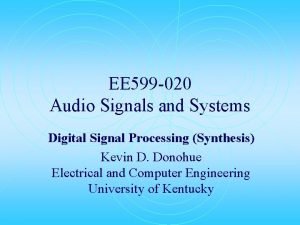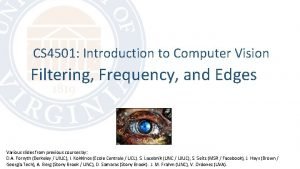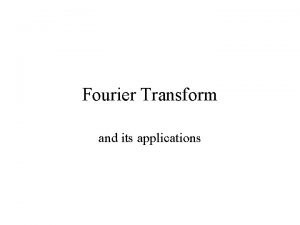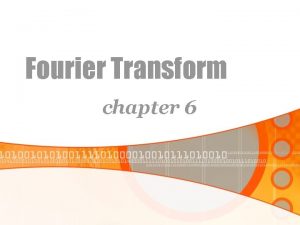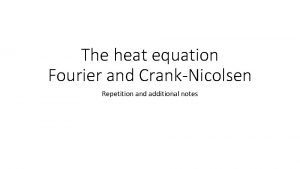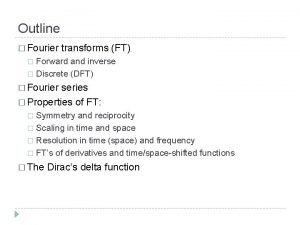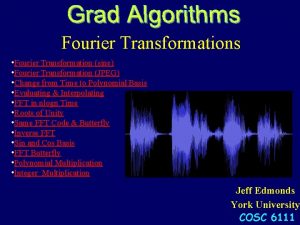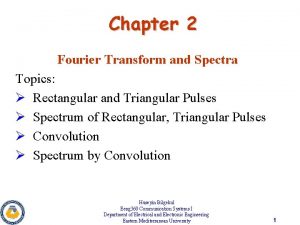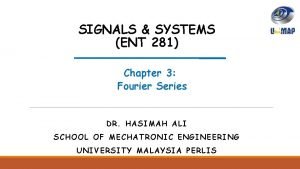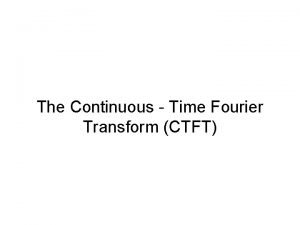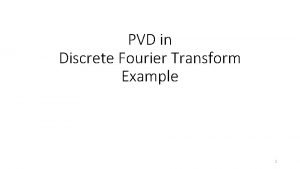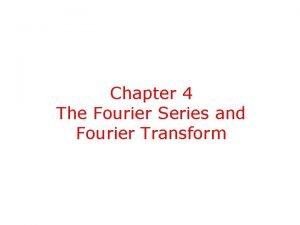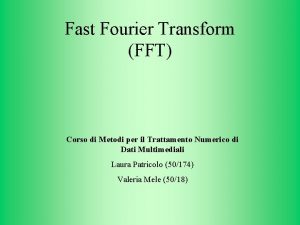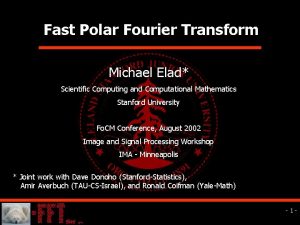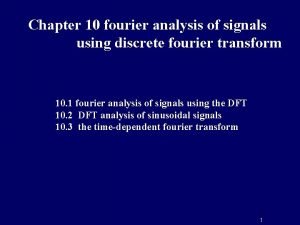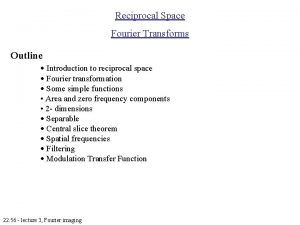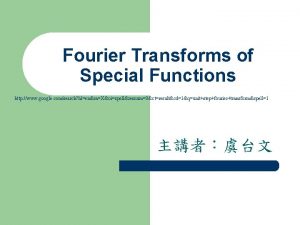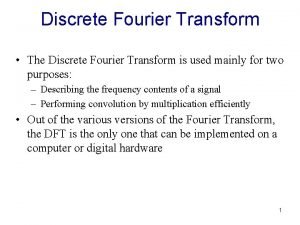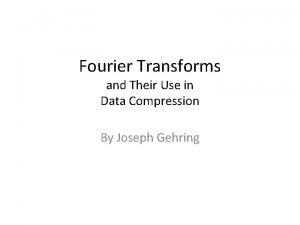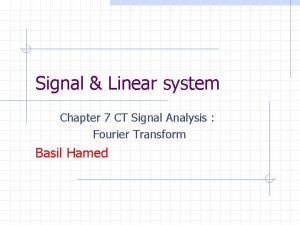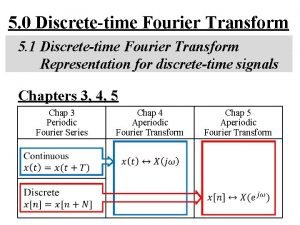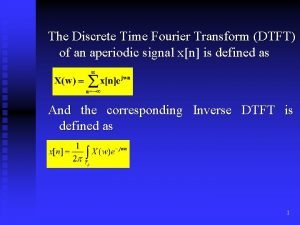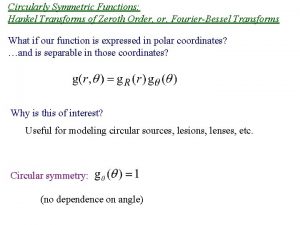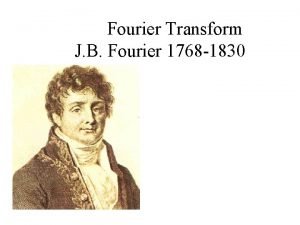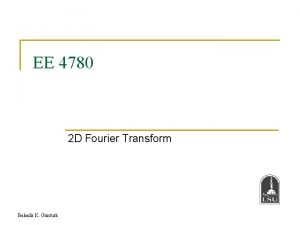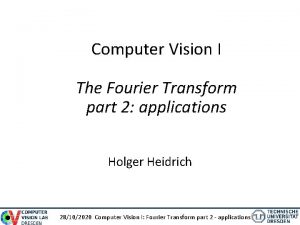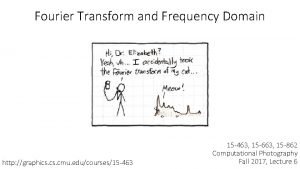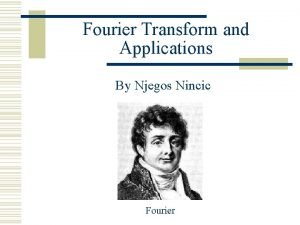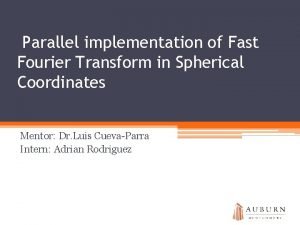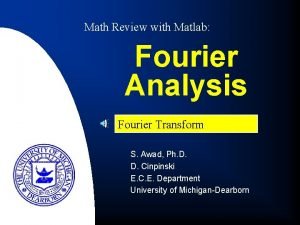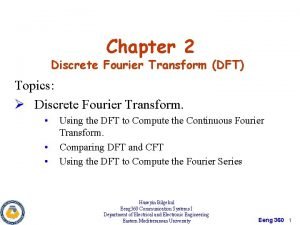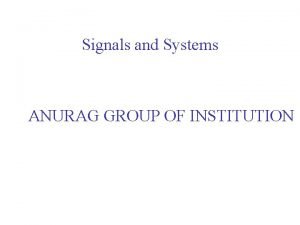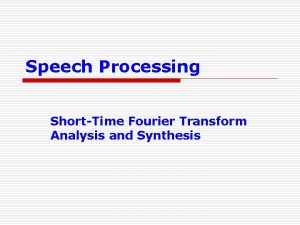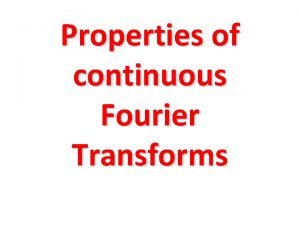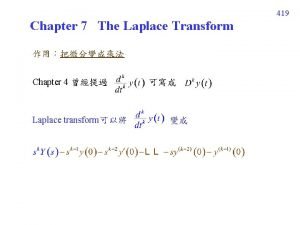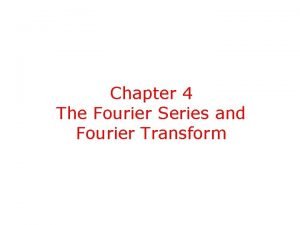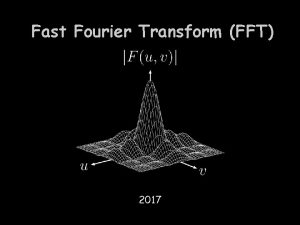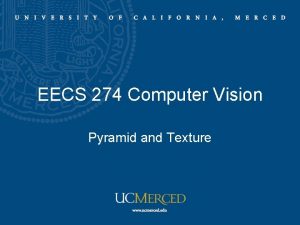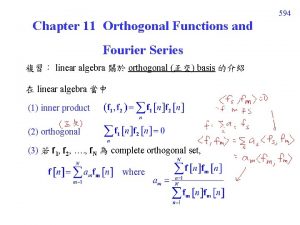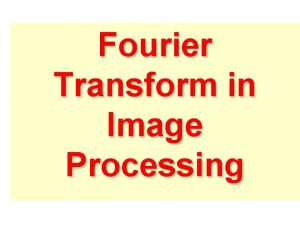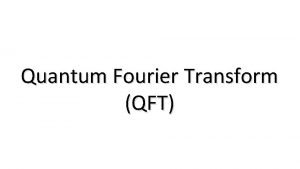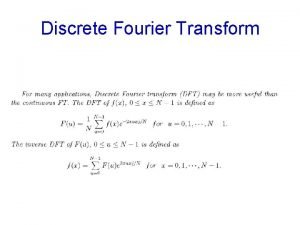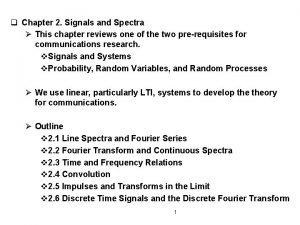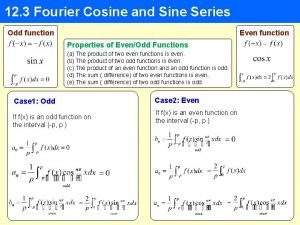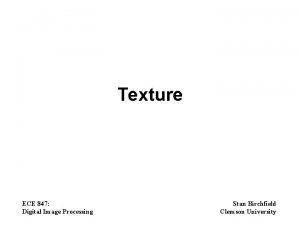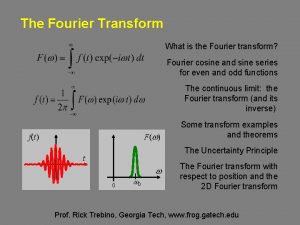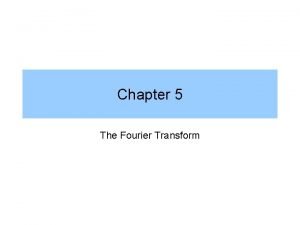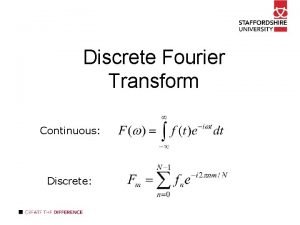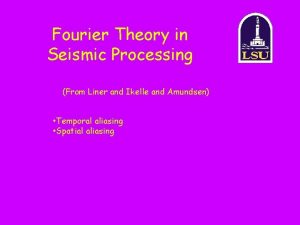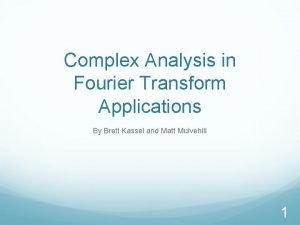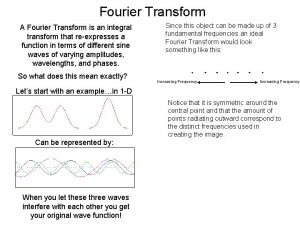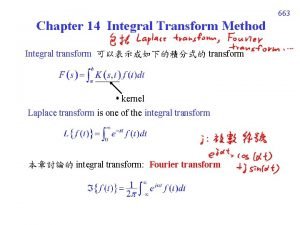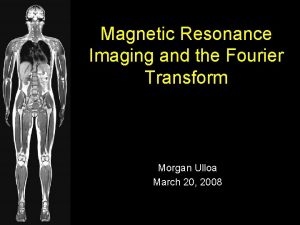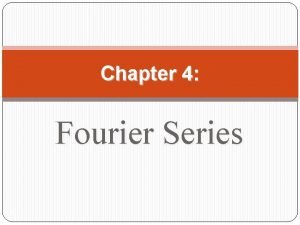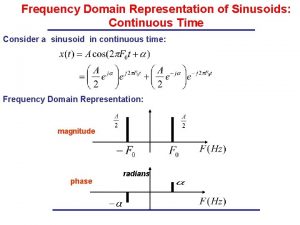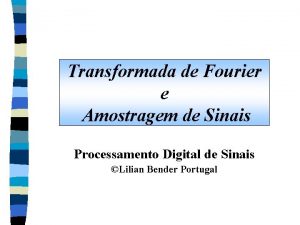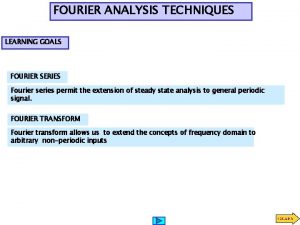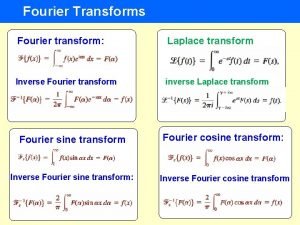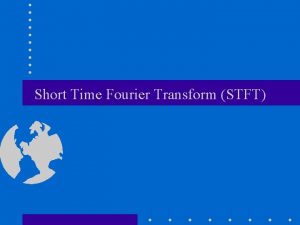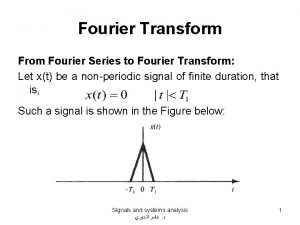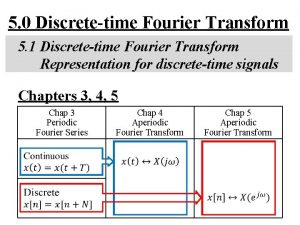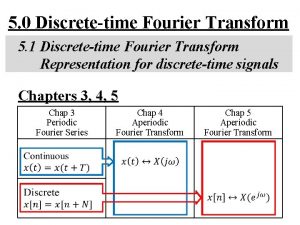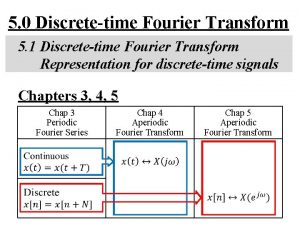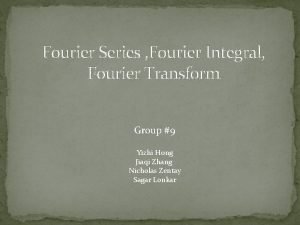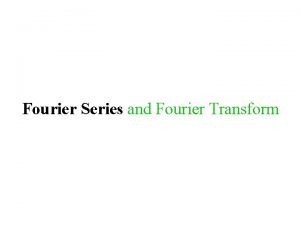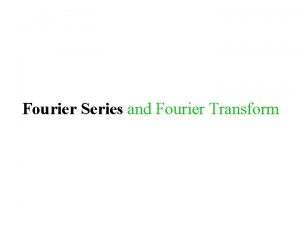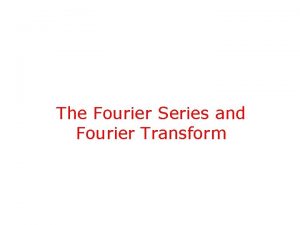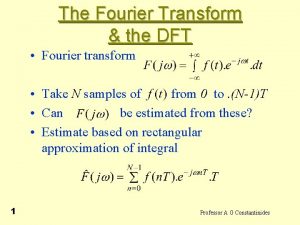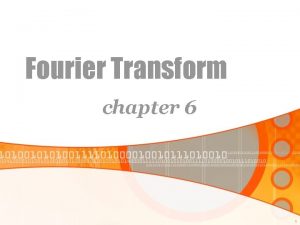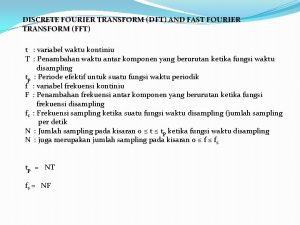5 0 Discretetime Fourier Transform 5 1 Discretetime



![Harmonically Related Exponentials for Periodic Signals (p. 11 of 3. 0) [n] (N) integer Harmonically Related Exponentials for Periodic Signals (p. 11 of 3. 0) [n] (N) integer](https://slidetodoc.com/presentation_image_h2/6da4b35b527d52d0e71135d629d09cb5/image-4.jpg)



![From Periodic to Aperiodic l Considering x[n], x[n]=0 for n > N 2 or From Periodic to Aperiodic l Considering x[n], x[n]=0 for n > N 2 or](https://slidetodoc.com/presentation_image_h2/6da4b35b527d52d0e71135d629d09cb5/image-8.jpg)
![From Periodic to Aperiodic l Considering x[n], x[n]=0 for n > N 2 or From Periodic to Aperiodic l Considering x[n], x[n]=0 for n > N 2 or](https://slidetodoc.com/presentation_image_h2/6da4b35b527d52d0e71135d629d09cb5/image-9.jpg)
![From Periodic to Aperiodic l Considering x[n], x[n]=0 for n > N 2 or From Periodic to Aperiodic l Considering x[n], x[n]=0 for n > N 2 or](https://slidetodoc.com/presentation_image_h2/6da4b35b527d52d0e71135d629d09cb5/image-10.jpg)

![From Periodic to Aperiodic l Considering x[n], x[n]=0 for n > N 2 or From Periodic to Aperiodic l Considering x[n], x[n]=0 for n > N 2 or](https://slidetodoc.com/presentation_image_h2/6da4b35b527d52d0e71135d629d09cb5/image-12.jpg)




![From Periodic to Aperiodic l Convergence Issues given x[n] – No convergence issue since From Periodic to Aperiodic l Convergence Issues given x[n] – No convergence issue since](https://slidetodoc.com/presentation_image_h2/6da4b35b527d52d0e71135d629d09cb5/image-17.jpg)







![From Periodic to Aperiodic l For Periodic Signals – Unified Framework – Given x[n] From Periodic to Aperiodic l For Periodic Signals – Unified Framework – Given x[n]](https://slidetodoc.com/presentation_image_h2/6da4b35b527d52d0e71135d629d09cb5/image-25.jpg)























![l Vector Space Interpretation {x[n], aperiodic defined on -∞ < n < ∞}=V is l Vector Space Interpretation {x[n], aperiodic defined on -∞ < n < ∞}=V is](https://slidetodoc.com/presentation_image_h2/6da4b35b527d52d0e71135d629d09cb5/image-49.jpg)







![<B> Fourier Series for Discrete-time Periodic Signals (Synthesis) (3. 94) (Analysis) (3. 95) -x[n] <B> Fourier Series for Discrete-time Periodic Signals (Synthesis) (3. 94) (Analysis) (3. 95) -x[n]](https://slidetodoc.com/presentation_image_h2/6da4b35b527d52d0e71135d629d09cb5/image-57.jpg)







![Harmonically Related Exponentials for Periodic Signals (p. 11 of 3. 0) [n] (N) integer Harmonically Related Exponentials for Periodic Signals (p. 11 of 3. 0) [n] (N) integer](https://slidetodoc.com/presentation_image_h2/6da4b35b527d52d0e71135d629d09cb5/image-65.jpg)































- Slides: 96

5. 0 Discrete-time Fourier Transform 5. 1 Discrete-time Fourier Transform Representation for discrete-time signals Chapters 3, 4, 5 Chap 3 Periodic Fourier Series Chap 4 Aperiodic Fourier Transform Chap 5 Aperiodic Fourier Transform

Fourier Transform (p. 3 of 4. 0) T FS 0

Discrete-time Fourier Transform 0
![Harmonically Related Exponentials for Periodic Signals p 11 of 3 0 n N integer Harmonically Related Exponentials for Periodic Signals (p. 11 of 3. 0) [n] (N) integer](https://slidetodoc.com/presentation_image_h2/6da4b35b527d52d0e71135d629d09cb5/image-4.jpg)
Harmonically Related Exponentials for Periodic Signals (p. 11 of 3. 0) [n] (N) integer multiples of ω0 ‧Discrete in frequency domain



![From Periodic to Aperiodic l Considering xn xn0 for n N 2 or From Periodic to Aperiodic l Considering x[n], x[n]=0 for n > N 2 or](https://slidetodoc.com/presentation_image_h2/6da4b35b527d52d0e71135d629d09cb5/image-8.jpg)
From Periodic to Aperiodic l Considering x[n], x[n]=0 for n > N 2 or n < -N 1 – Construct
![From Periodic to Aperiodic l Considering xn xn0 for n N 2 or From Periodic to Aperiodic l Considering x[n], x[n]=0 for n > N 2 or](https://slidetodoc.com/presentation_image_h2/6da4b35b527d52d0e71135d629d09cb5/image-9.jpg)
From Periodic to Aperiodic l Considering x[n], x[n]=0 for n > N 2 or n < -N 1 – Fourier series for – Defining envelope of
![From Periodic to Aperiodic l Considering xn xn0 for n N 2 or From Periodic to Aperiodic l Considering x[n], x[n]=0 for n > N 2 or](https://slidetodoc.com/presentation_image_h2/6da4b35b527d52d0e71135d629d09cb5/image-10.jpg)
From Periodic to Aperiodic l Considering x[n], x[n]=0 for n > N 2 or n < -N 1 – As signal, time domain, Inverse Discrete-time Fourier Transform spectrum, frequency domain Discrete-time Fourier Transform – Similar format to all Fourier analysis representations previously discussed

l Considering x(t), x(t)=0 for | t | > T 1 (p. 10 of 4. 0) – as spectrum, frequency domain Fourier Transform signal, time domain Inverse Fourier Transform pair, different expressions very similar format to Fourier Series for periodic signals
![From Periodic to Aperiodic l Considering xn xn0 for n N 2 or From Periodic to Aperiodic l Considering x[n], x[n]=0 for n > N 2 or](https://slidetodoc.com/presentation_image_h2/6da4b35b527d52d0e71135d629d09cb5/image-12.jpg)
From Periodic to Aperiodic l Considering x[n], x[n]=0 for n > N 2 or n < -N 1 – Note: X(ejω) is continuous and periodic with period 2 Integration over 2 only Frequency domain spectrum is continuous and periodic, while time domain signal is discretetime and aperiodic Frequencies around ω=0 or 2 are lowfrequencies, while those around ω= are high-frequencies, etc. See Fig. 5. 3, p. 362 of text For Examples see Fig. 5. 5, 5. 6, p. 364, 365 of text




![From Periodic to Aperiodic l Convergence Issues given xn No convergence issue since From Periodic to Aperiodic l Convergence Issues given x[n] – No convergence issue since](https://slidetodoc.com/presentation_image_h2/6da4b35b527d52d0e71135d629d09cb5/image-17.jpg)
From Periodic to Aperiodic l Convergence Issues given x[n] – No convergence issue since the integration is over an finite interval – No Gibbs phenomenon See Fig. 5. 7, p. 368 of text




Rectangular/Sinc

l Fourier Transform for Periodic Signals – Unified Framework (p. 14 of 4. 0) – Given x(t) (easy in one way)

Unified Framework (p. 15 of 4. 0) T FS

l Fourier Transform for Periodic Signals – Unified Framework (p. 16 of 4. 0) – If F
![From Periodic to Aperiodic l For Periodic Signals Unified Framework Given xn From Periodic to Aperiodic l For Periodic Signals – Unified Framework – Given x[n]](https://slidetodoc.com/presentation_image_h2/6da4b35b527d52d0e71135d629d09cb5/image-25.jpg)
From Periodic to Aperiodic l For Periodic Signals – Unified Framework – Given x[n] See Fig. 5. 8, p. 369 of text


From Periodic to Aperiodic l For Periodic Signals – Unified Framework – If See Fig. 5. 9, p. 370 of text


5. 2 Properties of Discrete-time Fourier Transform l Periodicity l Linearity

l Time/Frequency Shift l Conjugation


l Differencing/Accumulation l Time Reversal

Differentiation (p. 28 of 4. 0) Enhancing higher frequencies De-emphasizing lower frequencies Deleting DC term ( =0 for ω=0)

Integration (p. 29 of 4. 0) dc term Enhancing lower frequencies (accumulation effect) De-emphasizing higher frequencies Accumulation (smoothing effect) Undefined for ω=0

Differencing/Accumulation Enhancing higher frequencies De-emphasizing lower freq Deleting DC term l Differencing/Accumulation

Time Reversal (p. 32 of 3. 0) unique representation for orthogonal basis l Time Reversal

l Time Expansion If n/k is an integer, k: positive integer See Fig. 5. 13, p. 377 of text See Fig. 5. 14, p. 378 of text



Time Expansion

Time Expansion

l Differentiation in Frequency l Parseval’s Relation

l Convolution Property frequency response or transfer function l Multiplication Property periodic convolution

Input/Output Relationship (P. 51 of 4. 0) l Time Domain 0 l 0 matrix vectors Frequency Domain eigen value eigen vector

Convolution Property (p. 53 of 4. 0)

l System Characterization l Tables of Properties and Pairs See Table 5. 1, 5. 2, p. 391, 392 of text


![l Vector Space Interpretation xn aperiodic defined on n V is l Vector Space Interpretation {x[n], aperiodic defined on -∞ < n < ∞}=V is](https://slidetodoc.com/presentation_image_h2/6da4b35b527d52d0e71135d629d09cb5/image-49.jpg)
l Vector Space Interpretation {x[n], aperiodic defined on -∞ < n < ∞}=V is a vector space – basis signal sets repeats itself for very 2

l Vector Space Interpretation – Generalized Parseval’s Relation {X(ejω), with period 2π defined on -∞ < ω < ∞}=V : a vector space inner-product can be evaluated in either domain

l Vector Space Interpretation – Orthogonal Bases

l Vector Space Interpretation – Orthogonal Bases Similar to the case of continuous-time Fourier transform. Orthogonal bases but normalized, while makes sense with operational definition.

Signal Representation in Two Domains Time Domain Frequency Domain

Summary and Duality (p. 1 of 5. 0) Chap 3 Periodic Fourier Series Chap 4 Aperiodic Fourier Transform Chap 5 Aperiodic Fourier Transform

5. 3 Summary and Duality <A> Fourier Transform for Continuous-time Aperiodic Signals (Synthesis) (4. 8) (Analysis) (4. 9) -x(t) : continuous-time (∆t→ 0) aperiodic in time (T→∞) -X(jω) : continuous in frequency(ω0→ 0) aperiodic in frequency(W→∞) Duality<A> :

Case <A> (p. 40 of 4. 0) 0 0
![B Fourier Series for Discretetime Periodic Signals Synthesis 3 94 Analysis 3 95 xn <B> Fourier Series for Discrete-time Periodic Signals (Synthesis) (3. 94) (Analysis) (3. 95) -x[n]](https://slidetodoc.com/presentation_image_h2/6da4b35b527d52d0e71135d629d09cb5/image-57.jpg)
<B> Fourier Series for Discrete-time Periodic Signals (Synthesis) (3. 94) (Analysis) (3. 95) -x[n] : discrete-time (∆t = 1) periodic in time (T = N) -ak : discrete in frequency(ω0 = 2 / N) periodic in frequency(W = 2 ) Duality<B> :

Case <B> Duality

<C> Fourier Series for Continuous-time Periodic Signals (Synthesis) (3. 38) (Analysis) (3. 39) -x(t) : continuous-time (∆t → 0) periodic in time (T = T) -ak : discrete in frequency(ω0 = 2 / T) aperiodic in frequency(W → ∞)

Case <C> <D> Duality <C> 0123 <D> For <C> For <D> Duality

<D> Discrete-time Fourier Transform for Discrete-time Aperiodic Signals (Synthesis) (5. 8) (Analysis) (5. 9) -x[n] : discrete-time (∆t = 1) aperiodic in time (T→∞) -X(ejω) : continuous in frequency(ω0→ 0) periodic in frequency(W = 2 )

<D> Discrete-time Fourier Transform for Discrete-time Aperiodic Signals Duality<C> / <D> For <C> For <D> Duality – taking z(t) as a periodic signal in time with period 2 , substituting into (3. 38), ω0 = 1 which is of exactly the same form of (5. 9) except for a sign change, (3. 39) indicates how the coefficients ak are obtained, which is of exactly the same form of (5. 8) except for a sign change, etc. See Table 5. 3, p. 396 of text


l More Duality – Discrete in one domain with ∆ between two values → periodic in the other domain with period – Continuous in one domain (∆ → 0) → aperiodic in the other domain
![Harmonically Related Exponentials for Periodic Signals p 11 of 3 0 n N integer Harmonically Related Exponentials for Periodic Signals (p. 11 of 3. 0) [n] (N) integer](https://slidetodoc.com/presentation_image_h2/6da4b35b527d52d0e71135d629d09cb5/image-65.jpg)
Harmonically Related Exponentials for Periodic Signals (p. 11 of 3. 0) [n] (N) integer multiples of ω0 ‧Discrete in frequency domain

l Extra Properties Derived from Duality – examples for Duality <B> duality

Unified Framework l Fourier Transform : case <A> (4. 8) (4. 9)

Unified Framework l Discrete frequency components for signals periodic in time domain: case <C> you get (3. 38) (applied on (4. 8)) Case <C> is a special case of Case <A>

l Fourier Transform for Periodic Signals – Unified Framework (p. 16 of 4. 0) – If F

Unified Framework l Discrete time values with spectra periodic in frequency domain: case <D> (4. 9) becomes (5. 9) Case <D> is a special case of Case <A> Note : ω in rad/sec for continuous-time but in rad for discrete-time

Time Expansion (p. 41 of 5. 0)

Unified Framework l Both discrete/periodic in time/frequency domain: case <B> -- case <C> plus case <D> periodic and discrete, summation over a period of N (4. 8) becomes (3. 94) (4. 9) becomes (3. 95)

Unified Framework l Cases <B> <C> <D> are special cases of case <A> Dualities <B>, <C>/<D> are special case of Duality <A> l Vector Space Interpretation ----similarly unified

Examples • Example 5. 6, p. 371 of text

Examples • Example 4. 8, p. 299 of text (P. 73 of 4. 0)

Examples • Example 5. 11, p. 383 of text time shift property

Examples • Example 5. 14, p. 387 of text



Examples • Example 5. 17, p. 395 of text

Examples • Example 3. 5, p. 193 of text (P. 60 of 3. 0) (a) (b) (c)

Problem 5. 36(c), p. 411 of text

Problem 5. 36(c), p. 413 of text

Problem 5. 46, p. 415 of text

Problem 5. 56, p. 422 of text

Problem 3. 70, p. 281 of text • 2 -dimensional signals (P. 67 of 3. 0)

Problem 3. 70, p. 281 of text • 2 -dimensional signals (P. 66 of 3. 0)

An Example across Cases <A><B><C><D>

l Time/Frequency Scaling (p. 31 of 4. 0) See Fig. 4. 11, p. 296 of text – inverse relationship between signal “width” in time/frequency domains – example: digital transmission (required bandwidth) α (bit rate)

Time/Frequency Scaling (p. 32 of 4. 0)

l Parseval’s Relation (p. 30 of 4. 0) total energy: energy per unit time integrated over the time total energy: energy per unit frequency integrated over the frequency

Single Frequency (p. 34 of 4. 0)

Single Frequency

Another Example

Cases <C><D>

Cases <B>
 Half range fourier series
Half range fourier series Fisher transform indicator pdf
Fisher transform indicator pdf Dft table
Dft table Relationship between laplace and fourier transform
Relationship between laplace and fourier transform Fourier transform of impulse signal
Fourier transform of impulse signal Formulas of laplace transform
Formulas of laplace transform Fourier transform formula table
Fourier transform formula table Fourier transform
Fourier transform Comb function matlab
Comb function matlab Sin(2pift)
Sin(2pift) Frft meaning
Frft meaning Phase meaning
Phase meaning R fft
R fft Chirped pulse fourier transform microwave spectroscopy
Chirped pulse fourier transform microwave spectroscopy Fourier transform formula
Fourier transform formula Sinc squared function
Sinc squared function Fourier transform of shifted delta function
Fourier transform of shifted delta function Windowed fourier transform
Windowed fourier transform Fourier transform definition
Fourier transform definition Inverse fourier transform
Inverse fourier transform Overlap save method
Overlap save method Applications of fourier transform
Applications of fourier transform Short time fourier transform
Short time fourier transform Fourier transform definition
Fourier transform definition Java fast fourier transform
Java fast fourier transform Fourier transform properties examples
Fourier transform properties examples Dft vs fft
Dft vs fft Sinc function fourier transform
Sinc function fourier transform Parseval's identity for fourier transform
Parseval's identity for fourier transform Introduction to fast fourier transform
Introduction to fast fourier transform L
L Fourier cosine transform of f(x)=1
Fourier cosine transform of f(x)=1 Fourier integral representation
Fourier integral representation Fourier transform
Fourier transform Sinc fourier transform
Sinc fourier transform Inverse of fourier transform
Inverse of fourier transform The fourier transform and its applications
The fourier transform and its applications Transformata laplace calculator
Transformata laplace calculator Heat equation fourier transform
Heat equation fourier transform Discrete fourier transform of delta function
Discrete fourier transform of delta function Transformation jpeg
Transformation jpeg Fourier transform of shifted rectangular pulse
Fourier transform of shifted rectangular pulse Exponential form of sin
Exponential form of sin By ct ft
By ct ft Fourier transform
Fourier transform Duality of fourier transform
Duality of fourier transform Fast fourier transform (fft)
Fast fourier transform (fft) Polar fourier series
Polar fourier series Fourier transform conclusion
Fourier transform conclusion Linearity property of fourier series
Linearity property of fourier series Fourier transform of reciprocal function
Fourier transform of reciprocal function Www.google.com
Www.google.com Fourier transform solver
Fourier transform solver What is discrete fourier transform
What is discrete fourier transform Jpeg fourier transform
Jpeg fourier transform Fourier transform properties table
Fourier transform properties table Duality of fourier transform
Duality of fourier transform Discrete time fourier transform
Discrete time fourier transform Fourier transform of circ function
Fourier transform of circ function Fourier transform
Fourier transform Fourier transform of impulse train
Fourier transform of impulse train Fourier transform in computer vision
Fourier transform in computer vision Inverse fourier transform formula
Inverse fourier transform formula Application of discrete fourier transform
Application of discrete fourier transform Fourier transform spherical coordinates
Fourier transform spherical coordinates Fourier transform of ramp function
Fourier transform of ramp function Fourier transform
Fourier transform Fourier transform formula list
Fourier transform formula list Short time fourier transform applications
Short time fourier transform applications Unit impluse
Unit impluse Proof of the convolution theorem
Proof of the convolution theorem Dirichlet condition for fourier series expansion
Dirichlet condition for fourier series expansion Fast fourier transform
Fast fourier transform Fourier transform of product of two functions
Fourier transform of product of two functions Orthogonal functions in fourier series
Orthogonal functions in fourier series Properties of fourier transform in digital image processing
Properties of fourier transform in digital image processing Complex fourier transform
Complex fourier transform Fourier transform of gaussian
Fourier transform of gaussian Application of discrete fourier transform
Application of discrete fourier transform Desmos convolution
Desmos convolution Rayleigh energy theorem
Rayleigh energy theorem Fourier sine and cosine series examples
Fourier sine and cosine series examples Image processing and analysis birchfield pdf
Image processing and analysis birchfield pdf Define inverse fourier transform
Define inverse fourier transform Rect t/2
Rect t/2 Fourier series pictures
Fourier series pictures Discrete fourier transform
Discrete fourier transform Fourier transform seismic
Fourier transform seismic Fourier transform complex analysis
Fourier transform complex analysis Fourier transform
Fourier transform Fourier transform pair
Fourier transform pair Frequency
Frequency Fourier series
Fourier series Time frequency
Time frequency Series de fourier
Series de fourier Decimação de sinais
Decimação de sinais Use of fourier series
Use of fourier series
